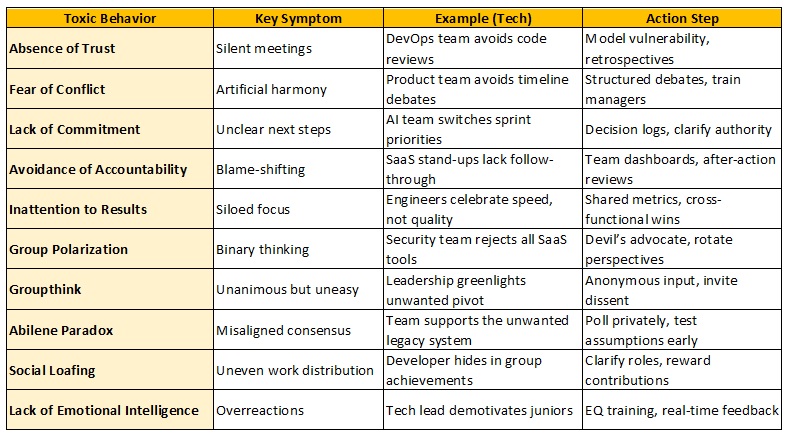
10 Toxic Team Behaviors Every Leader Should Know How to Handle
Business Coaching
Signs of toxic team dynamics
Toxic team dynamics are silent performance killers, especially in tech environments where cross-functional collaboration, rapid decision-making, and high cognitive load are the norm.
The signs are subtle at first:
● Lack of honest feedback
● Confusing or delayed decisions
● Meetings that feel performative
● Quiet disengagement
In fast-growing or digitally transforming companies, these behaviors escalate quickly if left unmanaged.
Patrick Lencioni’s and five others
This article outlines 10 toxic behaviors that derail team performance: 5 based on Patrick Lencioni’s well-known five dysfunctions (presented as standalone points, not in his pyramid order), and 5 drawn from psychological and organizational research, including Hackman, Edmondson, Janis, and the contemporary field of study in organizational behavior.
For each toxic behavior, we’ll give you:
● A simple definition
● Typical symptom
● A tech-industry example
● Targeted actions to resolve
● Where relevant, also metrics, inclusion notes, or remote work considerations
Let’s dive in.
LENCIONI-BASED TEAM TOXIC BEHAVIORS
1️⃣ Absence of Trust (Interpersonal)
● Definition: Team members don’t feel safe being vulnerable or honest with one another.
● Symptoms: Silent meetings, reluctance to ask for help, defensive posturing.
● Causes: Lack of relationship-building, prior negative experiences, mixed team norms.
● Example: After a merger, developers on a new DevOps team avoid peer code reviews to avoid appearing inexperienced.
● Fix: Leaders must model vulnerability: admit mistakes, ask questions, show uncertainty. Build in relational rituals like retrospectives and feedback exchanges.
● Metrics: Trust pulse surveys; psychological safety questions from Amy Edmondson’s scale.
● Remote note: Trust erosion is harder to detect virtually. Watch for reduced 1:1 engagement or camera-off culture.
2️⃣ Fear of Conflict
● Definition: Teams avoid debate to keep surface-level peace, leading to poor decisions and unresolved tension.
● Symptoms: Passive-aggressive feedback, over-alignment, private disagreement.
● Causes: Hierarchical leadership, cultural norms discouraging disagreement, fear of punishment.
● Example: A product team avoids discussing unrealistic feature deadlines until it causes burnout and delays.
● Fix: Normalize healthy conflict. Use structured debate (red team/blue team). Train leaders to stay neutral and guide difficult discussions.
● Metrics: Number of disagreements surfaced constructively; use of dissent tools like Slido.
● Remote note: Written communication can mask conflict. Leaders must read tone carefully and schedule real-time discussions.
3️⃣ Lack of Commitment
● Definition: Team members don’t fully buy into decisions, resulting in hesitation and inefficiency.
● Symptoms: Waffling priorities, second-guessing, ambiguity on ownership.
● Causes: Over-consensus culture, lack of clarity on decision rights, unresolved objections.
● Example: An AI team keeps reprioritizing sprints mid-cycle because no one is aligned with the roadmap.
● Fix: Use clear decision-making frameworks (like RAPID or RACI). Publicly document decisions and dissent. End meetings with explicit commitments.
● Metrics: Decision clarity in retrospectives; frequency of scope changes mid-sprint.
4️⃣ Avoidance of Accountability
● Definition: Teams rely on the leader to enforce standards; peers don’t hold each other responsible.
● Symptoms: Recurring missed deadlines, excuses, leader overload.
● Causes: Weak norms, unclear expectations, no public performance feedback.
● Example: A SaaS development team has weekly standups, but no one addresses unfinished work from the prior sprint.
● Fix: Build accountability into rituals: daily huddles, dashboards, peer feedback. Set consequences early and fairly.
● Metrics: Completion rates; peer-to-peer feedback scores.
● Remote note: Accountability may drop with asynchronous workflows. Reinforce clarity in documentation.
5️⃣ Inattention to Results
● Definition: Individuals or teams prioritize their own success over shared outcomes.
● Symptoms: Protecting turf, optimizing for vanity metrics, low alignment.
● Causes: Misaligned KPIs, unclear impact pathways, internal competition.
● Example: A team prioritizes product speed over quality, resulting in high churn and support tickets.
● Fix: Align all teams on shared OKRs. Celebrate results that come from collaboration. Remove silos from recognition systems.
● Metrics: Team-based OKRs; customer satisfaction indicators.
● Inclusion angle: Create shared goals that require diverse inputs to reinforce collaboration.
RESEARCH-BASED TOXIC BEHAVIORS IN MODERN TECH BUSINESSES
6️⃣ Group Polarization
● Definition: Group discussions push teams toward more extreme positions than individuals initially held.
● Symptoms: Overconfidence, echo chambers, binary thinking.
● Causes: Homogeneity of thought, lack of external input, emotional framing.
● Example: A security team blocks all third-party tools, ignoring cost-saving, vetted options.
● Fix: Rotate devil’s advocates. Use structured decision matrices. Bring in outside perspectives or user research.
● Metrics: Number of decisions reconsidered after dissent; diversity in decision-making groups.
● Inclusion angle: Promote cognitive diversity. Include dissenters, domain outsiders, and underrepresented voices.
7️⃣ Groupthink
● Definition: The team prematurely aligns on a course of action to preserve harmony, avoiding dissent or critical thinking.
● Symptoms: Fast, unanimous decisions with later regrets. Discomfort expressing opposing views.
● Causes: Power imbalances, fear of exclusion, time pressure.
● Example: A digital transformation team agrees to a platform pivot to “stay on trend,” despite internal doubts.
● Fix: Use anonymous voting tools. Ask: “Who disagrees and why?” Include dissenters in planning.
● Remote note: Camera-off calls and rapid chat consensus can hide disagreement—probe deeper asynchronously.
8️⃣ Abilene Paradox
● Definition: Everyone agrees to a course of action because they think others want it. Even though no one personally supports it.
● Symptoms: Unwanted decisions, resentment, rapid course corrections.
● Causes: Diffuse responsibility, unclear communication norms, fear of rocking the boat.
● Example: A tech team agrees to support a legacy system “because that’s what leadership wants,” even though leadership assumed the team preferred deprecating it.
● Fix: Use private pre-reads and anonymous polling. Ask directly: “Are we doing this because we all want it or because we think others do?”
● Metrics: Frequency of initiative rollback or low engagement post-decision.
● Remote note: Asynchronous tools help surface individual opinions early. Before group bias kicks in.
9️⃣ Social Loafing
● Definition: Team members exert less effort when work responsibility is shared.
● Symptoms: One or two people carry most of the work, while others disengage.
● Causes: Lack of role clarity, weak ownership structures, no visibility.
● Example: In a hybrid setup, a few team members dominate sprint delivery while others go unnoticed.
● Fix: Use small, focused teams. Assign named deliverables. Recognize contributions clearly and regularly.
● Metrics: Effort-to-output visibility by person; participation rates in retrospectives.
🔟 Lack of Emotional Intelligence (EQ)
● Definition: Inability to understand or manage one’s own emotions and empathize with others.
● Symptoms: Escalation of tensions, miscommunication, withdrawal.
● Causes: Stress, lack of awareness, absence of EQ development.
● Example: A team lead frequently interrupts with sarcasm, unaware of the demoralizing impact.
● Fix: Offer EQ training. Use 360 reviews. Coach teams on affect labeling and self-regulation.
● Metrics: Feedback from pulse surveys; reduction in team escalations.
● Inclusion angle: EQ supports equity. managers with high EQ are better at inclusion and coaching underrepresented groups.
Diversity, Inclusion, and Remote Contexts Matter
Tech teams are often global, hybrid, or remote-first. These structures amplify the risks of miscommunication, isolation, and unspoken dynamics.
● Remote teams need extra support for trust, clarity, and inclusion.
● Diverse teams—when led inclusively—are less prone to groupthink and more resilient to polarization.
Inclusive leadership practices—such as shared airtime, cultural humility, and anti-bias reflection—don’t just feel good. They reduce team toxicity.
Summary of Key Toxic Behaviors and Solutions
Preventability of Toxic Team Behaviors
Toxic team dynamics are preventable. But only if seen early and handled skillfully.
This guide is your starting point. Addressing dysfunctions means more than “fixing people.” It means:
● Adjusting structures
● Training leaders
● Tracking progress
● Promoting inclusion across every layer of the business
Need help?
Profecta BDI helps businesses:
● Develop toxic-behavior-free teams
● Train conflict-smart communication
● Build trust systems
● Embed inclusive leadership in remote and hybrid teams
Contact us at info@profectabdi.com and let’s explore how we can help you unlock performance through healthier team dynamics.





